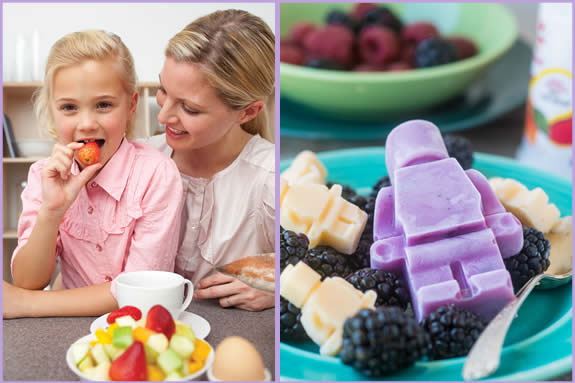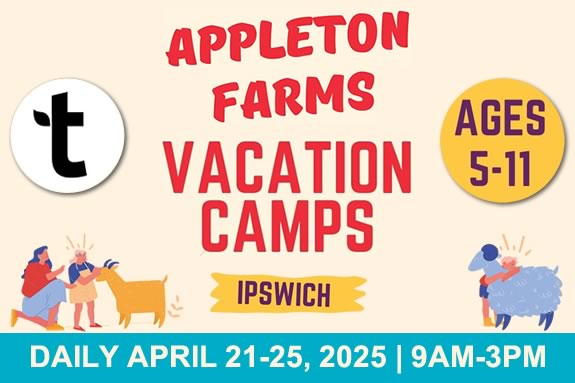
The vegetable your child tolerates today may be old news tomorrow. Their eating habits are unpredictable and that’s normal. Your eating habits and the way you speak about food, however, are major influences in forming their life-long habits.
It’s important to teach children that you eat to fuel your body and your brain. Marit Pywell, RDN, CDE, a nutritionist at Anna Jaques Hospital, shared 7 habits that will have you feeling great while leaving a lasting impression on the kids. Prepare your meal schedule and the meals for your family with these tips in mind.
- Eat a small, balanced breakfast every day within 90 minutes of waking up. This gets your metabolism going so your body can burn calories at an optimal rate. Make sure your breakfast consists of complex carbs and lean protein. Breakfast is the most important meal of the day – for everyone! Find a way to sit and eat with the kids, they’ll likely want to join you.
- Avoid going more than four hours without eating. If you aren’t eating a meal, have a small snack with protein to prevent your metabolism from slowing down. You don’t want to overindulge at your next meal because you are too hungry. This is especially important for children. Keeping them on a routine eating schedule and staying ahead of their hunger is a win-win.
- Include lean protein with all of your meals and snacks. Lean protein is important for your child’s growth and development. It also helps you feel full. Examples include foods such as lean meats, fish and poultry; cheese (low fat cheese is best); yogurt, nuts, peanut butter, soy, eggs, and beans. Many of them are great included in a stir-fry or as part of a pasta dish and can easily be included in a snack.
- Follow the balanced plate model when planning your lunch and dinner. Fill up on non-starchy vegetables such as green salads, broccoli and carrots. Remember, peas, corn and potatoes count as your starch. Introduce new vegetables to your children at every meal but don’t engage in battles over eating the vegetables. It will take time. Continue to include them in the meals and eat them in front of your children.
- Before eating an unplanned snack or meal, ask yourself “Am I really hungry or, am I bored, stressed or looking for some emotional comfort from food?” If you cannot answer “yes”, avoid emotional eating by distracting yourself for 20 minutes. Parents preparing food for kids often find themselves picking out of the bags, even off the kids plates. Be mindful of what you are putting in your mouth. If you are hungry, get yourself a snack.
- If you are concerned about your weight or dieting, manage this message to your children. Instead of saying, “I am on a diet so I’m eating an apple.” shift your focus to teaching the habit and change your message. “Fruit is delicious and I haven’t had any yet today. Do you want some?” OR “I love apples, they are so good.”
- Be mindful that you are eating to fuel your body and mind. This will help you make healthy choices for every meal and every snack. It’s easy to reach for the junk food but that doesn’t have any nutritional benefits. There are ways to make snacks and treats fun and healthy. Check out the frozen yogurt snack recipe in this article.
Be sure to combine healthy eating with at least 5 days of a 30-minute exercise routine that gets your heart rate up. And incorporate active play for the kids every day. Remember, modeling these behaviors is as great for the kids as it is for you!
Struggling to maintain a healthy weight, meet your personal nutritional requirements or need to change your eating habits because of a disease or health condition? Please consult your PCP or specialist.
SIDEBAR/BRIEF
When You’re On the Go, Remember:
Carb + Protein = Healthy Snack Combination
When you’re all on the go, it’s important to keep everyone well fed. Here are some adult and kid-friendly snack combinations that travel well. It helps to package these combinations together.
- 1oz string cheese or ¼ cup nuts and a small piece of fruit
- Carrots, cherry tomatoes, cucumber or celery sticks with 2 Tbsp. hummus or 2 Tbsp. salad dressing
- Popcorn trail mix: 1 cup of popcorn mixed with ¼ cup of nuts and 1 tbsp dried cranberries
- 3 tbsp hummus with a 4” whole wheat pita bread
- 1 cup of soy crisps or hummus chips
- 1 sheet of graham crackers with peanut butter or SunButter
Remember, carry a bottle of water for everyone to drink.
(sidebar – recipe, fine to just include intro and link to…just an add-on for parents
FROZEN YOGURT SNACKS
Source and photos:
http://www.superhealthykids.com/healthy-fun-frozen-yogurt-snacks/
Blog cited in recipe is:
http://theviewfromgreatisland.com/category/frozen-yogurt/
Picture from google images:
http://cf.theviewfromgreatisland.com/wp-content/uploads/2016/03/frozen-yogurt-snacks1.jpg
Frozen yogurt sticks or cups are a great healthy go-to snack. You can also make a fun variation by pouring the yogurt into a mold. Any type of yogurt will freeze well - plain and flavored, whole fat or non-fat. You can also use soy, almond, or coconut yogurt. Consider adding in your own fruit puree or even chia seeds.
Tip: If you don’t have a mold, put the yogurt in a small plastic bag, cut the tip off and squeeze little blobs onto a cookie sheet (consider using an icing tip) then freeze.
Directions:
- Stick to small flexible silicone mold shapes for best results. Hard plastic molds won’t work.
- Fill the mold with your choice of yogurt.
- Run a knife across the surface of the mold to remove any excess yogurt.
- Tap the mold sharply on the counter several times to make sure the yogurt fills every nook and cranny.
- Be sure to place your yogurt on a flat surface in the freezer until solid.
- Push from the underside of the mold to easily pop out the frozen yogurt.
- Serve it immediately or wrap in plastic and put back in the freezer.
Frozen yogurt melts quickly so plan to eat it soon after removing from the freezer. It’s best to consume the frozen yogurt shapes within a day or two after you make them.
Source: Super Healthy Kids, www.superhealthykids.com
DIRECT LINK: http://www.superhealthykids.com/healthy-fun-frozen-yogurt-snacks/
Photo: Help the children in your life develop healthy eating habits. Eat as if they are always watching. You’ll enjoy the benefits too.
Balanced plate caption: The balanced plate helps you design your meals to meet the target portions. Fill half of your plate with vegetables, no more than one quarter of your plate with a starch (less than 1 cup), and at least the remaining quarter with a protein.











